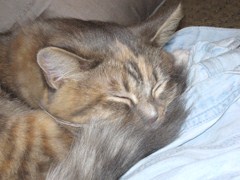 Cats are very good at relaxing. A cat at rest presents a pleasant scene. Makes me smile. But as easily and convincingly a cat can be at rest, she can also spring to action without warning. That ability is part of her survival mechanism. However, most cats, who feel safe in their surroundings, will wake up slowly, stand and stretch and yawn before insisting on a meal, a treat, or a scratch behind the ear. Some will take a long lick-bath before going on to the next task on their agenda—bird-watching, strolling through the garden, climbing in the middle of your current project, or begging for food…
Cats are very good at relaxing. A cat at rest presents a pleasant scene. Makes me smile. But as easily and convincingly a cat can be at rest, she can also spring to action without warning. That ability is part of her survival mechanism. However, most cats, who feel safe in their surroundings, will wake up slowly, stand and stretch and yawn before insisting on a meal, a treat, or a scratch behind the ear. Some will take a long lick-bath before going on to the next task on their agenda—bird-watching, strolling through the garden, climbing in the middle of your current project, or begging for food…
It’s always interesting to see some of the positions a  sleeping or at-rest cat gets into. A cat can put Gumby to shame with their contortions. But there’s good reason for that. Cats are put together with forty more bones than the human body has—an average of 244 in all. You’d think all those bones would work against each other and prevent the cat from moving with ease. But on the contrary, they’re structured so that the cat can turn and twist and even make herself skinnier than she really is.
sleeping or at-rest cat gets into. A cat can put Gumby to shame with their contortions. But there’s good reason for that. Cats are put together with forty more bones than the human body has—an average of 244 in all. You’d think all those bones would work against each other and prevent the cat from moving with ease. But on the contrary, they’re structured so that the cat can turn and twist and even make herself skinnier than she really is.
 The cat’s clavicle, for example, (collarbone), is not attached to any other bones and this helps the cat squeeze into small spaces. The spine joints are looser than many other animals spines are and this enables them to twist in mid air and (most of the time) land on their feet.
The cat’s clavicle, for example, (collarbone), is not attached to any other bones and this helps the cat squeeze into small spaces. The spine joints are looser than many other animals spines are and this enables them to twist in mid air and (most of the time) land on their feet.
Here’s an interesting fact: As cats age, they have fewer bones because they start growing together—fusing. Experts say that a cat’s bone structure is always under construction. Here’s an interesting article on the topic. http://www.cat-health-detective.com/catbonestructure.html





